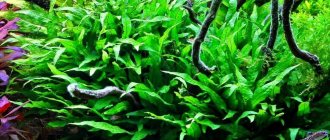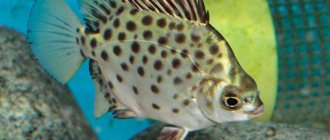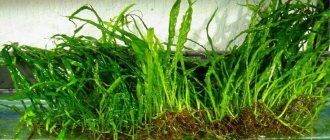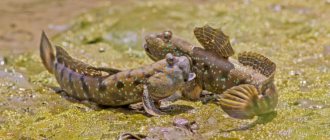The Thai fern, or, as it is also called, wing fern, is one of the popular varieties of aquarium evergreen plants. It is quite unpretentious in terms of maintenance and care. Even novice aquarists can grow Thai fern without much effort. This plant will help you easily and efficiently decorate your home aquarium.
Thailand fern will help perfectly decorate your aquarium
general description
The fern is also called Java fern. In its natural habitat, this plant can be found in Southeast Asia. In nature, the fern can grow up to 50 cm in length. However, when grown at home in an aquarium, this green pet grows only up to 30 cm. This is explained by the fact that the plant does not have enough natural light and is kept under artificial lamps all year round.
There are several different varieties of Thai fern, which differ in the shape of the leaves and their sizes. The most common types are:
- narrow-leaved;
- with needle-like leaves;
- vindelov;
- lanceolate.
The appearance and size of the Thai fern may depend on the geographical location.
In nature, plants prefer to settle on a rocky bottom covered with silt, on large snags. The culture clings to various supports with the help of its rhizoids, which are thread-like formations. Spores are clearly visible on the leaves of this aquatic culture, which become much darker during the ripening period. The leaves have an elongated lanceolate shape, constantly reaching towards the surface of the water. The leaf blades are quite bright and have a rich green tint. If all the necessary growing rules are followed at home, the aquatic crop can grow into bushy and dense thickets.
In an aquarium it can be planted both in groups and individually in the form of an unusual bush. The Thailand fern is quite easy to grow in an aquarium as it does not require CO2 or strong light or additional fertilizer.
Thailand fern is not picky about environmental conditions
What does the narrow-leaved Thai fern look like?
Externally, the plant resembles a lush green bush, consisting of a large number of leaves. Each leaf is attached to a long fleecy stem and seems to stretch out from it.
Microsorum pteropus "Narrow" (this is the Latin name of the plant) can have different sizes, depending on the conditions in the home pond.
- If there is little light and no additional carbon dioxide is supplied, the leaf will not grow more than 10 cm in length and 5 mm in width. In addition, the color will become too dark.
- If light and nutrition are plentiful, then the length of the leaf will increase to 15-20 cm and the width to 10 mm.
Main varieties
There are several types of this plant for growing at home, which can currently be found on sale. Some of them appeared naturally, and some were bred by breeders who specifically carried out work on developing new varieties. The most common of them are:
- Thai angustifolia fern. Its main feature is the presence of narrow and long leaves. If you provide this variety with proper care, the leaf blades can grow up to 20 cm in length. However, if the plant is not maintained correctly, the leaves will not grow more than 10 cm. The thickets of this variety of fern are somewhat reminiscent of dwarf dense forests, where, by the way, aquarium fish like to spawn. The variety grows slowly; only one new leaf is formed in one month. However, many aquarists prefer to grow this particular type of fern, as it always looks impressive in composition with other aquatic plantings.
The Thai angustifolia fern is most often grown in aquariums due to its appearance. - Thai wing fern. Many also prefer to grow this variety of fern for its ease of care, unusual appearance, and low growth rate. At home, the spectacular dark green leaf blades can grow up to 30 cm, while forming dense and beautiful thickets in the aquarium. It is best to plant this variety in a container around the perimeter or in the very center of the underwater world. However, there is another very original variety of pterygoid fern. It was bred artificially by breeders from Tropica Aquarium Plants. This fern differs from its ancestor in its decorative appearance - the leaf plates at the end have carved edges, making the green rosette look much more attractive. However, this variety grows to a maximum length of 15 cm, so it is recommended to plant the fern in the very center of the aquarium or closer to the front.
Wing fern has wide leaves in the form of plates - Undulata. This species differs from the others in its softness and tenderness of the leaf plates. The leaves are light green, wavy, and similar in shape to aponogeton. The variety is considered quite rare; this plant is difficult to find on sale. The cost for it, by the way, is higher than for other types.
- Philippine wing fern. This variety has gained wide popularity in recent years. The plant has graceful narrow leaves. It is worth noting that the culture does not take root well in soft and acidic water, which is considered very unsurprising, since in its natural habitat it prefers to grow in slightly salty waters. If water conditions are unsuitable for the fern, holes and black spots may form on the leaf blades. Optimal conditions for growing: water hardness 10 dgh and pH at least 6.6. The variety is ideal for keeping in salt aquariums. Just like other varieties, the Philippine wing fern requires little light and CO2. This plant is distinguished by its very fast growth rate; its leaves can reach a length of 40 cm.
- Vindel fern. A rather attractive and interesting variety, which is loved by many aquarists for its unusual leaves with branched tips. The maximum length of one plate is 20 cm. The plant is considered very undemanding in maintenance, so it is ideal for beginners. Herbivorous aquarium fish do not eat this crop.
The leaves of the vindel fern have many tips of different types and shapes - Tropica fern. Externally, this plant has some common features with the dandelion rosette: the fern’s plates are also divided into three parts. Mature leaves can reach a length of 40 cm. The bush grows large, so it is ideal for decorating the back wall of an aquarium. The fern is also very undemanding in terms of care and maintenance.
- Taiwan fern. This variety is quite rare; it is almost impossible to find it at home. However, regarding its decorative properties, this plant cannot be found equal.
Types of spectacular ferns
In addition to the main popular types of ferns, there are less common, but no less beautiful varieties. These include:
- Azolla Caroline;
- Malay;
- Hornwort;
- Marsilia.
Azolla Carolinas is a fern-like aquarium plant that grows not only in water, but also above the surface. An adult azolla covers part of the water surface with a green carpet. If the water fern has grown too much, then half of it can be removed. The stem of Azolla, located under water, is covered with spores and leaves of pinkish-green color, and the upper part of the plant is green-blue and massive. Azolla is unpretentious, grows well in the warm season, and hibernates in winter. Suitable water temperature is 22–28C; when it drops below 16C, Azolla stops development and dies. Required lighting - average, daylight hours should last 12 hours
Features of care and maintenance
There are several basic rules that must be followed when growing ferns at home. The successful growth and development of the underwater plant will depend on this. First of all, it is necessary to constantly monitor the temperature of the aquatic environment, the chemical indicators of water, the quality of the soil and the brightness of the lighting.
If you follow the rules of caring for the Thai fern, the plants will have an excellent appearance.
Those people who have only recently begun to master the art of growing aquarium fish at home can safely choose aquatic fern to decorate their water corner. However, for this it is necessary to take into account some nuances. Basic conditions for successful cultivation and propagation of ferns:
- The chemical composition of the liquid in the aquarium. The water in the container should have a hardness of about 6 dgh, and the acidity should be from 5.5 to 7 PH. Old aquarium water usually has these characteristics, so it is not recommended to replace it often. The liquid can be renewed in parts, 20% every two weeks.
- Water temperature . The aquatic plant grows very poorly in cool water. If the temperature of the liquid drops to 18 degrees, this can cause the growth of foliage and root systems to stop, so ideal conditions are an aquatic environment whose temperature is about 24 degrees.
- Lighting brightness. In order for the aquatic fern to please the eye with its powerful, bright, exotic, green leaves, it is recommended to provide it with 12 hours of daylight.
The daylight hours of the Thai fern last half a day
Landing in the ground
When planting all species that form rhizomes, this part of the plant should not be buried in the ground. Most often, aquarists press the plant down with stones so that it does not float up. As the fern develops, it takes root on its own. Rhizoids penetrate between grains of sand of any fraction and are able to absorb humic acids dissolved in water, so there is no need to use nutrient substrates or plant the plant in a container with soil.
Ferns should not be planted in a pond where soil-digging fish live . A weak root system will not be able to support the fern, and it will constantly float up. If you want to decorate such an aquarium with ferns, choose large species and fix them on a massive base (lava, stone, etc.).
Landing rules
Planting a fern in an aquarium is quite simple. As a rule, this plant develops quickly on any soil without providing it with carbon dioxide, if it is artificially attached to some heavy object, for example, a stone or massive snag. Slow growth is considered a definite advantage, since there is no need for frequent pruning of green spaces and removal of unnecessary shoots.
Thailand fern can grow without carbon dioxide, which allows it to take root in any conditions
To plant Thai fern in your underwater world, you can use different methods. Any of them are good and easy to use for both beginners and professional aquarists. Products that can be used to decorate an aquarium at home:
- Fastening using a simple fishing line.
- Attaching the fern to driftwood or stones using nylon thread.
- Use of rubber bands. This type of fastening is the most reliable, but it will look unattractive in the aquarium.
- Quite often, people use waterproof super-glue of the “Moment” type to attach ferns to the aquarium. However, in this case, you should not completely cover the plate with adhesive; it should only be applied in a few drops in the required places. At the point of gluing, the roots will fall off, but by this time the plant will have time to grow and will sit firmly on the support.
How to fix it on a stone or driftwood?
This procedure can be carried out in various ways. All of them are quite practical and suitable for every person, since scrap materials that are found in every modern apartment are used to secure the plant.
Actually, you can attach the fern as follows:
Fishing line. It is in every house where a fisherman lives. But if not, then it can be purchased at any specialized store, and it is quite inexpensive. The advantage of fishing line is that it does not dissolve in water and looks invisible if you do not reel in too much. But when tying a bush, you need to be careful, since the fishing line can easily cut a leaf or stem. Accordingly, there is no need to tighten too much;
Thread. The ideal option is nylon, since this material resists water well and is generally very reliable. If it is not there, then ordinary cotton threads will do. But their disadvantage is that over time they can dissolve in water. Therefore, the fern should be wrapped well, “conscientiously.” Especially if the aquarium contains ancistrus and other similar fish that like to “explore” everything;
Wire . The best fit are those small scraps that are used to wrap new headphones and other wires (for example, when buying a computer, mouse, keyboard, etc.). They do not affect the water in any way and are very easy to use. Tying ferns with thread is very inconvenient if you do it right in the aquarium and not in the room. Wire wins significantly in this sense. We attach the bush to the branch, wrap it with a piece of wire and spirally twist it from behind, gradually tightening it so that the plant does not dangle;
Glue "Moment". It is important that it is of high quality and waterproof. Just a few drops on the roots and press them to the stone. They, of course, will die off, but by that time the Thai fern will have become stronger and will be able to cling on on its own.
Reproduction methods
To successfully propagate a water fern at home, the bush must be divided into several pieces , each of which should contain several plates and a small part of the root system.
Thailand fern is easily propagated by cuttings
However, another method can be used for this purpose, which involves the use of growth buds formed on an old, almost destroyed leaf, where a new rhizome begins to form.
When the leaf blade dies completely, the young plant breaks away from the mother plant, stretching upward. After this, the roots develop and pull the entire fern down to the ground.
Possible diseases
This aquatic crop does not have a real root system; the plant draws all its microelements directly from the water. If there is not enough nitrogen or other elements, the growth of the Thai fern will slow down and some problems may also appear. Quite often, the leaf blades of this aquatic plant begin to turn black if the hardness of the water environment increases, so beginners should regularly monitor and control the chemical composition of the water.
To prevent the occurrence of diseases in the Thai fern, you need to monitor the purity of the water.
In addition, some aquarium fish can cause damage to the root system when they dig up the soil. If you quickly remove damaged areas of the fern, this will promote rapid growth of new foliage and roots.
Compatibility
The Thai fern for an aquarium is of particular value due to the rigid structure of its leaves, so in a tank with herbivorous fish the plant is a real miracle, capable of surviving and performing its decorative functions. The microsorium is placed in the same reservoir with many fish, for example, swordtails, anubias, angelfish, cichlids and even turtles.
But the Thai aquarium fern is incompatible with fish that love to dig the ground, for example, catfish or agamixis. Such a neighborhood will lead to a violation of the integrity of the plant roots, and, accordingly, to the death of the microsorium.
Decorating a small aquarium
To create a beautiful water landscape in a small aquarium, you will need to take a special approach and use your imagination.
Of course, it will be quite simple to buy aquarium fish and an expensive tank, which is equipped with all the necessary electrical appliances, but if it is not properly designed, all this work and expense will be in vain, and the underwater world will take on an unattractive, poor appearance.
This video shows how to grow a Thai fern:
With the help of an aquarium plant of the Thai fern, you can create absolutely any composition, in which it is also recommended to include other decorative elements and stones. All this will take a little time and a little effort.
When properly maintained, the Thai angustifolia fern or other varieties of this plant will form graceful rosettes of bright green leaves that will not take up much space in the aquarium. This culture can instantly revive the aquatic environment among stones or a lonely snag. The plant is ideal for forming a water alley. To do this, a frame of the required size is created, after which pre-prepared rhizomes of seedlings are attached using fishing line or other materials. In just a few months you can have an attractive green hedge.
Possible problems
Most often, aquarium cultures suffer from poor water and soil conditions, which can lead to a lack of macro- and microelements important for growth. Signs of illness:
- leaves turn black;
- green mass decreases in size;
- fern grows very slowly;
- the appearance of yellow veins.
To restore the balance of essential microelements, you will need to adjust the acidity of the liquid, as well as additionally use fertilizers for aquarium plants.
See below for information on aquarium ferns.











